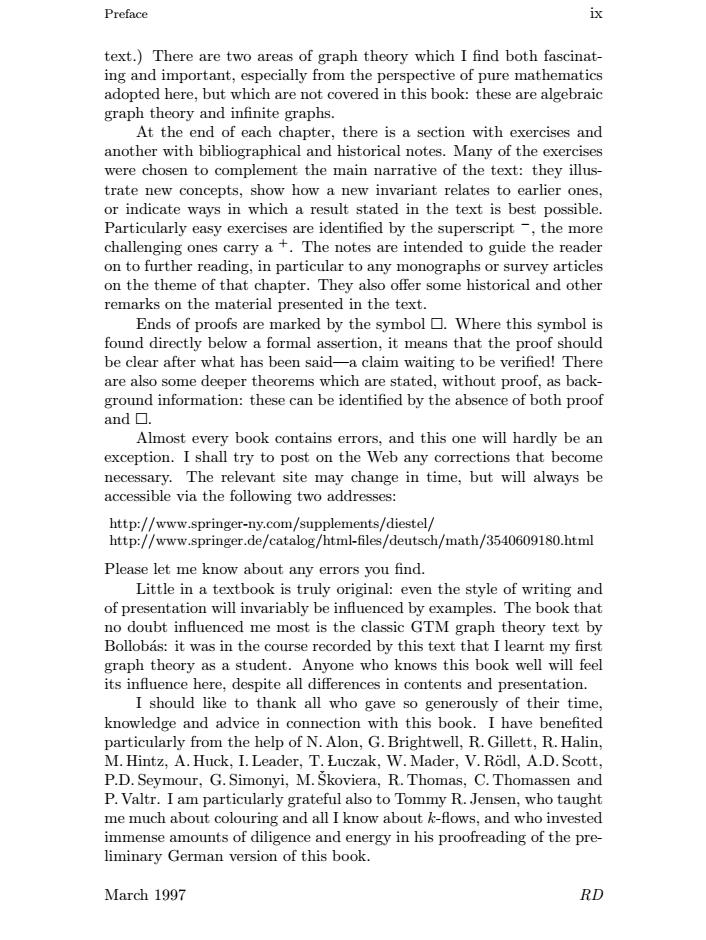正在加载图片...

Prefaceixtext.) There are two areas of graph theory which I find both fascinat.ing and important, especially from the perspective of pure mathematicsadopted here, but which are not covered in this book: these are algebraicgraph theory and infinite graphs.At the end of each chapter, there is a section with exercises andanother with bibliographical and historical notes. Many of the exerciseswere chosen to complement the main narrative of the text: they illus-trate new concepts, show how a new invariant relates to earlier ones.or indicate ways in which a result stated in the text is best possible.Particularly easy exercises are identified by the superscript , the morechallenging ones carry a +. The notes are intended to guide the readeron to further reading, in particular to any monographs or survey articleson the theme of that chapter. They also offer some historical and otherremarks on the material presented in the text.Ends of proofs are marked by the symbol . Where this symbol isfound directly below a formal assertion, it means that the proof shouldbe clear after what has been said-a claim waiting to be verified! Thereare also some deeper theorems which are stated, without proof, as back-ground information: these can be identified by the absence of both proofand Almost every book contains errors, and this one will hardly be anexception. I shall try to post on the Web any corrections that becomenecessary. The relevant site may change in time, but will always beaccessible via the following two addresses:http://www.springer-ny.com/supplements/diestel/http://www.springer.de/catalog/html-files/deutsch/math/3540609180.htmlPlease let me know about any errors you find.Little in a textbook is truly original: even the style of writing andof presentation will invariably be influenced by examples. The book thatno doubt influenced me most is the classic GTM graph theory text byBollobas: it was in the course recorded by this text that I learnt my firstgraph theory as a student. Anyone who knows this book well will feelits influence here, despite all differences in contents and presentationI should like to thank all who gave so generously of their time,knowledge and advice in connection with this book. I have benefitedparticularly from the help of N.Alon, G.Brightwell, R. Gillett, R. Halin.M. Hintz, A.Huck, I. Leader, T, Luczak, W. Mader, V, Rodl, A.D.Scott,P.D. Seymour, G.Simonyi, M.Skoviera, R. Thomas, C. Thomassen andP. Valtr. I am particularly grateful also to Tommy R. Jensen, who taughtme much about colouring and all I know about k-flows, and who investedimmense amounts of diligence and energy in his proofreading of the pre-liminary German version of this book.March 1997RDPreface ix text.) There are two areas of graph theory which I find both fascinating and important, especially from the perspective of pure mathematics adopted here, but which are not covered in this book: these are algebraic graph theory and infinite graphs. At the end of each chapter, there is a section with exercises and another with bibliographical and historical notes. Many of the exercises were chosen to complement the main narrative of the text: they illustrate new concepts, show how a new invariant relates to earlier ones, or indicate ways in which a result stated in the text is best possible. Particularly easy exercises are identified by the superscript −, the more challenging ones carry a +. The notes are intended to guide the reader on to further reading, in particular to any monographs or survey articles on the theme of that chapter. They also offer some historical and other remarks on the material presented in the text. Ends of proofs are marked by the symbol . Where this symbol is found directly below a formal assertion, it means that the proof should be clear after what has been said—a claim waiting to be verified! There are also some deeper theorems which are stated, without proof, as background information: these can be identified by the absence of both proof and . Almost every book contains errors, and this one will hardly be an exception. I shall try to post on the Web any corrections that become necessary. The relevant site may change in time, but will always be accessible via the following two addresses: http://www.springer-ny.com/supplements/diestel/ http://www.springer.de/catalog/html-files/deutsch/math/3540609180.html Please let me know about any errors you find. Little in a textbook is truly original: even the style of writing and of presentation will invariably be influenced by examples. The book that no doubt influenced me most is the classic GTM graph theory text by Bollob´as: it was in the course recorded by this text that I learnt my first graph theory as a student. Anyone who knows this book well will feel its influence here, despite all differences in contents and presentation. I should like to thank all who gave so generously of their time, knowledge and advice in connection with this book. I have benefited particularly from the help of N. Alon, G. Brightwell, R. Gillett, R. Halin, M. Hintz, A. Huck, I. Leader, T. Luczak, W. Mader, V. R¨odl, A.D. Scott, P.D. Seymour, G. Simonyi, M. Skoviera, R. Thomas, C. Thomassen and ˇ P. Valtr. I am particularly grateful also to Tommy R. Jensen, who taught me much about colouring and all I know about k-flows, and who invested immense amounts of diligence and energy in his proofreading of the preliminary German version of this book. March 1997 RD�